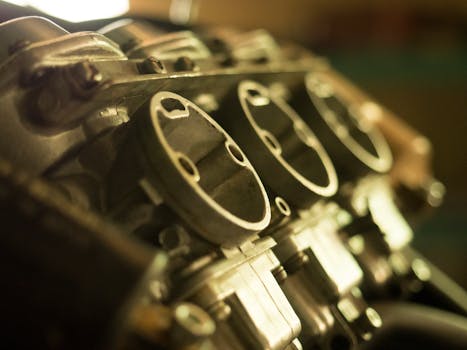Our Location
Titanium and aluminum are both popular metals known for their unique properties, making them ideal for diverse applications. While they share similarities, such as being lightweight and resistant to corrosion, each metal has its own distinct advantages and disadvantages.
In this article, we will dig into the main characteristics of titanium and aluminum, focusing on their strength, cost, and suitability for various industries. By understanding the differences between the two metals, you will be better equipped to make correct decisions when selecting materials for your projects.
Table of Contents
ToggleOn the periodic table, the symbol for titanium is Ti, and the atomic number is 22. The primary alloying element used with titanium is aluminum. Additionally, other elements such as vanadium, iron, and molybdenum can be included to create titanium alloys.
The symbol for aluminum is Al, and its atomic number is 13. Magnesium is the primary alloying element used with aluminum, but various other elements, such as silicon, copper, zinc, iron, manganese, titanium, zirconium, and chromium, can also be added in different amounts to create specific alloys.
The chemical composition of these two alloys can be adjusted to enhance their performance for specific applications. For instance, adding vanadium to titanium can increase its strength and ductility, while adding magnesium can enhance the strength of aluminum and improve its corrosion resistance. Therefore, the chemical composition is essential in determining the suitability and properties of these alloys for different tasks.
Titanium has a much higher melting point, ranging from 1650 to 1670°C, while aluminum melts at a lower temperature between 582 and 652°C. This significant difference in melting points makes titanium perfect for high-temperature applications, such as jet engines. Under these conditions, aluminum would quickly lose its structural stability.
Both metals are recognized for their lightweight properties, although aluminum is significantly lighter than titanium. Its density is only 2.7 g/cm³, while titanium is approximately 60% heavier, with a density of 4.5 g/cm³. The low density of aluminum makes it ideal for projects that require weight savings. In contrast, the higher density of titanium enhances its strength.
Both aluminum and titanium exhibit good corrosion resistance; however, titanium is superior due to its ability to form a stable oxide layer that remains effective even in harsh conditions.
While aluminum also develops a protective oxide layer, it is less resistant to alkalis and acids. Consequently, titanium is generally favored in industries such as marine, medical, and chemical. On the other hand, aluminum is better suited for environments with minimal chemical exposure.
In terms of pure strength, titanium clearly outperforms aluminum. The tensile strength of titanium alloys ranges from 600 to 1250 MPa, while aluminum alloys only possess a tensile strength ranging from 70 to 700 MPa.
While titanium is heavier, it offers a superior strength-to-weight ratio. This makes it particularly valuable for applications requiring high strength and low weight.
Aluminum is not as strong, but its strength-to-weight ratio is reasonable, making it popular for projects that balance cost and weight.
Aluminum is an advanced conductor of heat and electricity compared to titanium. The thermal conductivity of aluminum ranges from approximately 210 to 237 W/m·K, and its electrical conductivity is about 30 to 64% that of copper. These properties make aluminum ideal for use in electrical components and heat sinks.
In contrast, titanium has a thermal conductivity of only 15 to 20% of that of aluminum, and its electrical conductivity is roughly 3% of copper’s. This is why titanium is rarely chosen for applications that require efficient conduction of electricity or heat.
Aluminum is easily machined because it is soft and has a low density. This results in faster cutting speeds and less tool wear. In contrast, titanium places more stress on machining tools. During its machining, a slower process and frequent tool changes are needed, which increases production time and costs.
Both titanium and aluminum can be welded; however, welding titanium requires a higher level of expertise. Aluminum, in contrast, is highly weldable and has numerous applications. Therefore, if weldability is a key criterion for material selection, aluminum is an excellent choice.
Compared to titanium, aluminum is relatively easier to form. All varieties of aluminum can be easily shaped into finished parts using various methods. For instance, different types of saws can cut aluminum profiles, while plasma, lasers, or water jets can create intricate aluminum parts with complex shapes. Although titanium can also be formed, it is not as easily workable as aluminum. Therefore, when formability is crucial for a project’s success, aluminum is the best choice.
Tensile strength commonly refers to the maximum stress a material can suffer when subjected to tension. For titanium and its alloys at ambient temperature, the ultimate tensile strength varies from 230 MPa ( always for the softest grades of commercially pure titanium) to 1400 MPa for high-strength alloys.
Aluminum alloys have significantly greater strength compared to pure aluminum. While pure aluminum possesses a tensile strength of 90 MPa, some heat-treatable aluminum alloys can exceed 690 MPa.
The yield strength is the maximum stress at which it begins to deform permanently. Commercially pure titanium (over 99% Ti) is a low- to medium-strength metal that is not well-suited for manufacturing aircraft structures or engines.
Pure aluminum has yield strengths ranging from 7 MPa to approximately 11 MPa, while aluminum alloys have yield strengths varying from 200 MPa to 600 MPa. As a result, the yield strength of aluminum alloys is greater than that of titanium.
The shear strength of a metal is a measure of its ability to withstand shear loads. Titanium has a shear strength rating ranging from 40 to 45 MPa, while aluminum’s shear strength can vary between 85 MPa and approximately 435 MPa. Consequently, if shear strength is a key factor in material selection, specific grades of aluminum may be more suitable than titanium.

Titanium is highly regarded for its excellent biocompatibility and non-reactive properties, making it suitable for use in bone plates, permanent implants, and dental fixtures. In contrast, aluminum is not appropriate for implants; instead, it is primarily utilized in lightweight medical devices, wheelchairs, and diagnostic equipment.
In the aerospace industry, titanium is utilized in the construction of landing gear, aircraft engines, and structural frames due to its exceptional strength-to-weight ratio and corrosion resistance. Conversely, aluminum remains crucial for manufacturing fuselages, airframes, and wings because of its ease of fabrication and lightweight characteristics.
The automobile industry uses aluminum for body panels and engine components, including radiator and transmission systems. Titanium is utilized in high-performance vehicles in motorsports, although it comes at a high cost.
In addition, its strength and durability make it perfect for various applications, including connecting rods, exhaust systems, and engine valves.
The building and construction industry utilizes a diverse range of materials to make structures, including bridges and skyscrapers.
Titanium is commonly used in heating and power systems because of its low thermal conductivity and ability to withstand extreme temperatures.
In contrast, aluminum is often used as a finishing material in construction. It is employed in roofing, as frames for doors and windows, and is particularly prevalent in interior design.
Titanium is known for its durability, strength, and elegant appearance, making it a welcomed choice for eyewear, luxury watches, and high-end sporting equipment.
In contrast, aluminum is versatile and cost-effective, which is why it is commonly used in kitchenware, electronic casings, and everyday household items.
Both aluminum and titanium are versatile metals with particular properties that make them ideal for diverse applications. While they share similarities, such as being lightweight and resistant to corrosion, they also have distinct advantages and disadvantages.
The best choice between aluminum and titanium ultimately depends on the special requirements of your application. By earnestly considering the advantages and disadvantages of each metal, you can make a correct decision and choose the material that best meets your needs.

